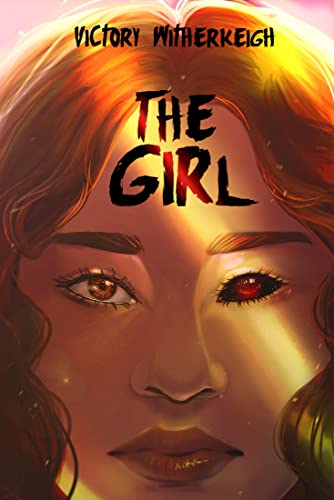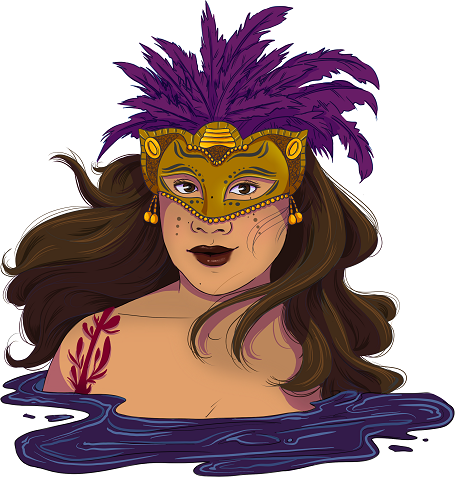I hope I’m a reminder to those who are immigrants, orphans, lonely and seeking refuge while living in challenging times that some of us who live in darkness do so to sit beside you and spin tales to pass the time — a beacon to show you’re not alone.
Victory Witherkeigh – 6 December 2022
The Back Flap
The parents knew it had been a mistake to have a girl. At birth, the girl’s long, elegant fingers wriggled and grasped forward, motioning to strangle the very air from her mother’s lungs. As she grew older, she grew more like her father, whose ancestors would dream of those soon to die. She walked and talked in her sleep, and her parents warded themselves, telling the girl that she was evil, unlovable, their burden to bear only until her eighteenth birthday released them.
The average person on the streets of Los Angeles would look at the girl and see a young woman with dark chocolate eyes, curly long hair, and tanned skin of her Filipina heritage. Her teachers praised her for her scholarly achievements and extracurricular activities, from academic decathlon to cheer.
The girl knew she was different, especially as she grew to accept that the other children’s parents didn’t despise them. Her parents whispered about their pact as odd and disturbing occurrences continued to happen around her. The girl thought being an evil demon should require the skies to bleed, the ground to tremble, an animal sacrifice to seal the bargain, or at least cause some general mayhem. Did other demons work so hard to find friends, do well on their homework, and protect their spoiled younger brother?
The demon was patient. It could afford to wait, to remind the girl when she was hurt that power was hers to take. She needed only embrace it. It could wait. The girl’s parents were doing much of its work already.
About the Book
What is the book about?
Girl. Athlete. Scholar. Scorned by her parents. Comforted by her demon.
When did you start writing the book?
I started writing portions or ideas for The Girl as far back as the early 2010s. But the first time I really sat down to pull the ideas together into a manuscript was in the fall of 2019.
How long did it take you to write it?
I completed The Girl’s first draft as an exercise for NaNoWriMo in November 2019.
Where did you get the idea from?
The idea came about during one of those sleepless, insomnia, panic attack evenings after I was coming down from a tough day at work. I studied Public Health in college, so my first few jobs after graduation were in various hospital systems… I’ll just leave it at that to keep it spoiler free.
Were there any parts of the book where you struggled?
Of course! I definitely found that I overwrite during the first draft phase, so I had a LOT of material to slice and dice. As a writer, any scene that explores feelings of vulnerability or emotional struggles, especially in coming-of-age stories, is heart-wrenching to write, imagine, or empathize with.
What came easily?
Without spoiling too much, I would say any traveling chapters were probably my favorite. All the real-world places mentioned in The Girl are trips I had taken myself as a young child through my teenage years, and it was so much fun to revisit those historic sites and cities.
Are your characters entirely fictitious or have you borrowed from real world people you know?
Both! I enjoyed looking more at certain traits, or even behavior patterns and thought patterns, of a person rather than their specific stories in character development. Sometimes, just one or two qualities because adding magic to any aspect of a story makes everything fictitious. Focusing on feelings or emotions and sensory responses was the best way to make certain characters and stories HEAVILY fictional. I wanted it to be more of a thought of how these characters would respond if this magical system was natural and had survived all these eons of colonial upheaval and destruction.
We all know how important it is for writers to read. Are there any particular authors that have influenced how you write and, if so, how have they influenced you?
Growing up, I was a very nerdy kid – reading R. L. Stine and Christopher Pike to Tolkien and C. S. Lewis. Garth Nix’s Abhorsen series and Neil Gaiman’s The Sandman comics were some of my favorite reads in my pre-teens and teens for the worlds they created. Leigh Bardugo and Tomi Adeyemi are some female writers I discovered as I entered adulthood. As a brown first-generation AAPI reader, finding any literature I could identify with was a struggle. Still, these authors helped me understand how a book could help one escape my current narrative entirely.
Do you have a target reader?
I think my target reader would be any teen (both in age or in spirit) who enjoy the genres of dark fantasy and horror and whose idea of fairytales they filled with the American dream of white picket fences and Hallmark family faces. I hope I’m a reminder to those who are immigrants, orphans, lonely and seeking refuge while living in challenging times that some of us who live in darkness do so to sit beside you and spin tales to pass the time — a beacon to show you’re not alone.
About Writing
Do you have a writing process? If so can you please describe it?
It depends on what I’m working on, but I started as a short story writer before I ever tried to write a book. I usually know the beginning and the ending I’m aiming for because of my short story background, but I like to leave room to see how the characters evolve, or the world reacts to things in case something needs changing. My usual goal is to do at least one hundred words a day on something to try and give my mental health as much freedom as possible. I am also a night owl, so I structure my days with errands and admin tasks first to get those off the table before I try to dive into a writing session.
Do you outline? If so, do you do so extensively or just chapter headings and a couple of sentences?
I don’t usually outline at the start of a project – I find that I’m usually okay if I just down the significant points I’m trying to hit, which gives me enough room to write. It may sound strange, but The Girl manuscript came as freeform chapters first, and I then outlined it as part of the editing phase once the first draft was completed. This gave me a big-picture view of all the pieces I had created, allowing me to think of outlining further ahead.
Do you edit as you go or wait until you’ve finished?
I am a writer who needs to wait until I finish the first draft to edit. If I try to do it in the middle – even if I can see the glaring errors, I will get too bogged down by the minutia to finish — especially when it’s the very emotional chapters. It’s easier for me to edit things on the page than on the fly.
Do you listen to music while you write? If yes, what gets the fingers tapping?
This depends on the type of scene I need to write or what stage I’m in for the work. I find I use intense, almost workout or gym music if I have long grinding sessions of writing about the world or even character development. I’ll use certain songs that stir emotions if I need to be in a particular feeling for a scene or try to brainstorm. The times I need the quietest are during editing scenes that may be very triggering or delicate to write, especially since I am often in dark fantasy and horror. The fine line between pushing violence or gore or sensitive topics too far in YA is particular, so silence gives me the most focus.
About Publishing
Did you submit your work to Agents?
I submitted to agents, as well as various writing contests, in the beginning. The manuscript for The Girl has been a finalist for Killer Nashville’s 2020 Claymore Award, a 2020 Cinnamon Press Literature Award Honoree, and long-listed in the 2021 Voyage YA Book Pitch Contest.
What made you decide to go Indie, whether self-publishing or with an indie publisher? Was it a particular event or a gradual process?
I think the last count I had in 2021 when I was querying the manuscript, was something over three hundred agents or publishers had said no. After all the “bombshells” of the publishing industry from 2020, I believed I would self-publish this book. But it was a serendipitous universe manifestation that I came across my publisher, Cinnabar Moth Publishing. I had another dark fantasy/horror short story in an anthology in 2021. That publisher was following Cinnabar’s Twitter account. During the press cycle of promoting the collection I was in, this publisher had retweeted Cinnabar’s announcement that a book title they had been hoping for in 2024 had fallen through. They were open to looking at manuscripts again. I honestly just replied to that tweet with a DM, saying I had a manuscript, thinking this is a Hail Mary and most likely a no — but they asked for my email. I sent the first three chapters over, and then they requested the rest of the book.
Did you get your book cover professionally done or did you do it yourself?
Someone professionally did my cover through Cinnabar Moth’s fantastic artist, Ira Geneve.
Do you have a marketing plan for the book or are you just winging it?
I’m really very lucky to say that although I’m with a small, predominantly Black-Owned press, our head of marketing has been very forthcoming with the publisher’s marketing plan and working in tandem with my publicist.
Any advice that you would like to give to other newbies considering becoming Indie authors?
I will pass along the same advice I received once I began my writing career: Be really honest with yourself about what you want on your book journey. For some writers, simply having the book finished is an achievement. For others, seeing that product on a bookstore shelf, industry awards, or sales records may be what you want. It’s important to know what you, as the creator, aim for to have the right frame of mind when researching who to query and what risks you will take versus what perks or comforts you might let go of. The other piece that I think doesn’t get reiterated enough is the knowledge that regardless of what you create, keep in mind you will not have control over the reactions or feelings evoked from its consumption, even if it is your core audience.
About You
Where did you grow up?
I grew up in Los Angeles, CA.
Where do you live now?
I now live in the Las Vegas, NV, area.
What would you like readers to know about you?
Fun Fact: I studied Tahitian and Hula dancing.
What are you working on now?
I actually have a couple of other spooky, scary short stories coming out hopefully October 2022 in two different horror anthologies with other small, indie presses that I’m reviewing for final edits.
End of Interview:


